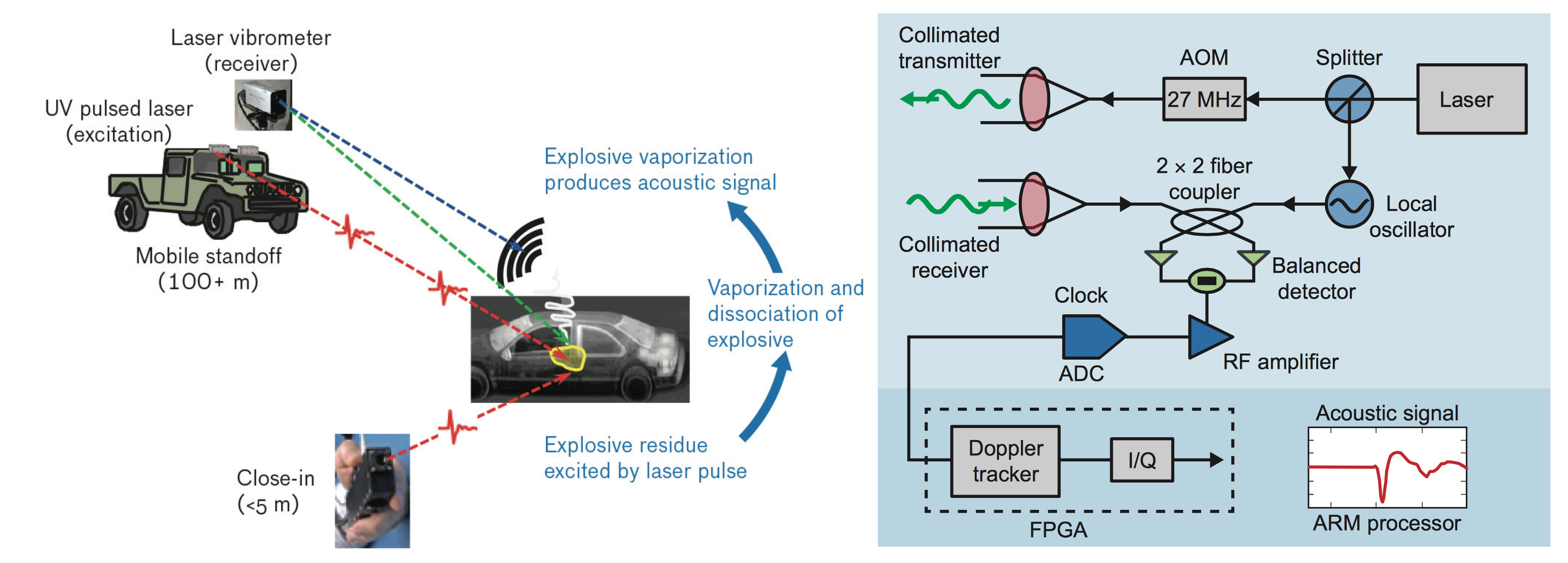Tech notes
Photoacoustic Sensing of Explosives
A modular, standoff, laser-induced acoustics system detects and discriminates trace amounts of explosive material.
Photoacoustic Sensing of Explosives (PHASE) is a promising new technology that detects trace explosive residues from significant standoff distances, providing early warning of concealed threats targeting civilians, military personnel, and public facilities. PHASE exploits photoacoustic phenomena resulting from ultraviolet laser excitation. Exposed explosives are excited up to 100 meters away by using PHASE's ultraviolet laser. The high peak power causes explosives to dissociate, vaporize, and release into the near atmosphere, producing intense local pressure variances and consequent acoustic signals.
 The overall dimensions of PHASE (11" by 7" by 4"), its weight (6 kg), and its power requirements (24 W) allow for the high portability of the system.
The overall dimensions of PHASE (11" by 7" by 4"), its weight (6 kg), and its power requirements (24 W) allow for the high portability of the system.In current practice, explosives screening is conducted manually, by visual inspection, by swabbing, and through X-ray analysis. Often, these inspections are random searches or depend on trained inspectors to select suspicious individuals. Current approaches can also be time-consuming, especially when screening individuals, containers, luggage, and packages one at a time in a conveyor-line approach. Although current techniques are successful, they are unable to cover all individuals, are difficult to implement for objects in large public areas, and are typically not covert.
PHASE mitigates these problems by detecting and discriminating exposed trace explosives deposited on common surfaces from significant standoffs. It can locate explosive deposits to within several millimeters (in static mode or on moving objects such as vehicle door handles) at concentrations from bulk down to 200 ng/cm2 (partial fingerprint). PHASE is designed to operate covertly, perhaps from a hidden standoff location, to view vehicles, containers, packages, or baggage.
 The laser vibrometer and processing algorithms clearly distinguish explosives' signatures from those of benign materials and background surfaces. These signatures, critical for discrimination, are predominant in the ultrasonic frequency band, well above human hearing.
The laser vibrometer and processing algorithms clearly distinguish explosives' signatures from those of benign materials and background surfaces. These signatures, critical for discrimination, are predominant in the ultrasonic frequency band, well above human hearing.Breakthrough Technologies
There are three fundamental components in explosives analysis: (1) "activation" of explosives, (2) sensing—recording signals related to the activated materials, and (3) discrimination—distinguishing between explosives and diverse background materials. PHASE's noncontact standoff explosives-sensing system achieves these results with
- An ultraviolet (UV) pulsed laser that induces photoacoustic phenomena in sampled areas.
- The discovery of high ultrasonic signal emissions in the photoacoustic process—a phenomenon discovered by Lincoln Laboratory—that leads to key explosive signature characteristics critical for discrimination from benign materials.
- A laser vibrometer that measures acoustic signals at frequencies up to 2 MHz. The receiver laser vibrometer senses the signals from the explosive components—a sensing modality developed by Lincoln Laboratory.
- Vibrometry algorithms that discriminate among the components—a process invented by Lincoln Laboratory.
PHASE's primary breakthrough development employs laser vibrometry to remotely measure photoacoustic emissions, enabling long standoff sensing and location accuracy within millimeters. PHASE performance analyses show photoacoustic signals from military-grade and certain forms of homemade explosives differ significantly from background materials such as soil, concrete, metal, clothing/fabric, and many others. PHASE can observe explosives versus common background materials with high detection probabilities and low false-alarm rates.
PHASE's second enabling breakthrough is the discovery of ultrasonic photoacoustic emissions from explosive dissociation and vaporization processes caused by UV excitation. Prominent acoustic signals measured with PHASE's laser vibrometer are rich in signature features depicting explosives' characteristics and enable discrimination from background materials. These explosives' acoustic emissions exhibit frequencies from 0.1–2 MHz, which are above microphone measurement capabilities.
 Here, the photoacoustic technique is depicted for a moving system. Note that the laser vibrometer measures the vibrations caused by the explosive vaporization process. At the same time, the vibrometer can also measure transient vibrations from the surface material. On the right is a schematic of the laser vibrometer module.
Here, the photoacoustic technique is depicted for a moving system. Note that the laser vibrometer measures the vibrations caused by the explosive vaporization process. At the same time, the vibrometer can also measure transient vibrations from the surface material. On the right is a schematic of the laser vibrometer module.Benefits of PHASE
PHASE applications include
- Luggage inspection passed through airports, train stations, and other public transportation
- Shipping container inspection to discover illegal transport of explosives or immediate threats to shipping vessels and personnel
- High-volume package inspections for postal and commercial delivery companies
- Checkpoint vehicle inspection for explosives hidden in trunks or storage compartments
- Vehicle-mounted search for covert manufacturing of homemade explosives
- Inspection of suspicious individual's clothing for explosives residue (e.g., suicide bomber)
In simple terms, PHASE has the potential to provide lightweight, rapid, and inexpensive detection of trace explosives from long standoff distances, statically or from moving vehicles, without alerting an adversary. Combined together, PHASE's features are the fundamental elements leading to the location of explosive devices and the apprehension of the perpetrators.
Posted November 2013
top of page